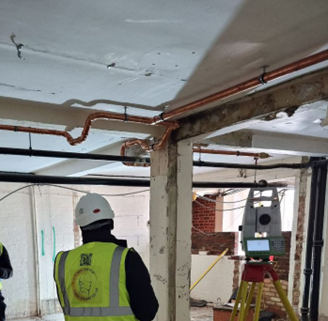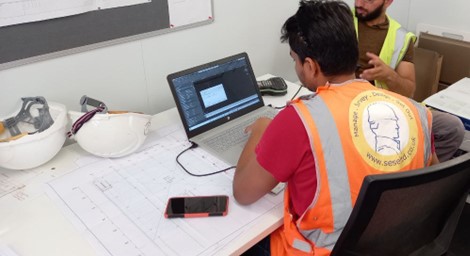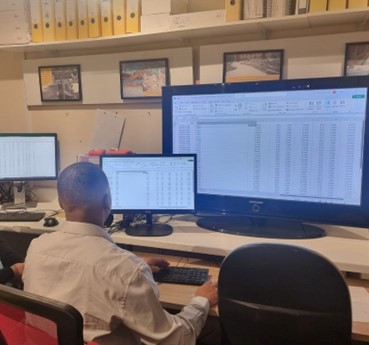RAAC Construction Monitoring
Call: 020 72 78 07 78

Providing RAAC Structural Movement and Building Monitoring Services throughout London, the South East, and now UK Countrywide, we detect changes in RAAC structural behaviour.
RAAC Planks or Reinforced Autoclave Aerated Concrete Planks have been in use since the mid-1950s. RAAC structures stayed in use on UK public sector buildings i.e., schools, hospitals, and council houses countrywide until the mid-1990s. Until the government became aware of its structural problems in 1994.
RAAC construction is still in use today in many countries around the world, particularly earthquake zones due to both its behaviour under seismic conditions and its weight advantage over standard concrete.
It is when RAAC floors and walls are not properly maintained or overloaded that they become prone to collapse. The real problem we have in the UK is that almost all these RAAC structures have now exceeded their 30-year design life.
Property managers, structural engineers and building surveyors often require the periodic movement monitoring of RAAC planks. Others need detailed measured building surveys of the deflection levels already present within floors, walls, and roof beams. RAAC construction monitoring is where we come in.
RAAC Visual Inspection Survey

If you are unclear as to whether your property contains Reinforced Autoclave Aerated Concrete, our team of engineering surveyors can carry out a non-intrusive visual inspection visit prior to your deciding on an appropriate course of action. However, things you can look out for yourself include:
A lack a visible aggregate. As RAAC is primarily made up of lime, water, and aerating agents, a major give away is the lack of large stones that are typically visible in standard concrete planks.
Clearly visible air pockets. RAAC Planks are designed to be full of tiny air bubbles, which is ultimately its problem; as when they become wet, the air bubbles make these concrete planks act like a sponge.
450 to 600mm wide and 2.4 to 6m long. RAAC planks are typically long spanning and rectangular in shape with v-chamfered edges on their underside.
If you think your roof, ceiling, or floor planks demonstrate these properties, and that you may need some RAAC construction monitoring; feel free to call us now for a no obligation visual inspection quote.
RAAC Structural Monitoring Survey

Our RAAC plank monitoring service is designed for those that already know their building contains Reinforced Autoclave Aerated Concrete. Given the level of urgency that this national problem requires, we have currently implemented a few special measures whereby, depending on the location of your building, we can start monitoring levels of deflection within RAAC planks immediately.
At SESE we have 2 RAAC movement monitoring service options:
- We can manually monitor the movement of your RAAC planks periodically. Returning to site at prescribed times, we confirm any changes in your levels of deflection over the period and notify you when we get close to any predetermined levels of change. We would gladly design our attendance around the needs of your environment, be it a school, block of flats, hospital, or former versions of any of the above properties that have now moved into private hands.
- We can automatically monitor the movement within your RAAC planks 24/7. Here you can opt to receive automated monitoring reports every morning (or every evening) confirming any changes that have taken place over the period. With this option, we can also send real-time email alerts to you if ever a predetermined deflection trigger level has been exceeded and a building warrant evacuation.
Our robotic red laser movement monitoring systems are a nonintrusive survey technique accurate to +/-2mm. As RAAC structures were widely used at the same time as asbestos fireproofing, we provide an ideal RAAC construction monitoring and movement survey solution for this problem given that many roofs, walls, and ceilings of this period are coated in asbestos; and it remains important to leave such surfaces undisturbed.
For more information on how we can help monitor your RAAC construction, email or call us now on 020 72 78 07 78.
How do I spot RAAC in our building?
A lack a visible aggregate. As RAAC is primarily made up of lime, water, and aerating agents, a major give away is the lack of large stones that are typically visible in standard concrete planks.
Clearly visible air pockets. RAAC Planks are designed to be full of tiny air bubbles, which is ultimately its problem; when they become wet, the air bubbles make these concrete planks act like a sponge.
450 to 600mm wide and 2.4 to 6m long. RAAC planks are typically long spanning and rectangular in shape with v-chamfered edges on their underside.
The government have also released further guidance on how to identify RAAC here.
.

